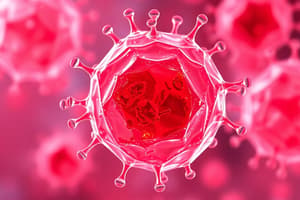Podcast
Questions and Answers
Which of the following conditions directly impairs ATP formation by inactivating cytochrome oxidase?
Which of the following conditions directly impairs ATP formation by inactivating cytochrome oxidase?
- Cyanide (correct)
- Lactic acid
- Oxalic acid
- Ethylene glycol
Which of the following is a critical factor in determining whether cell injury is reversible or irreversible?
Which of the following is a critical factor in determining whether cell injury is reversible or irreversible?
- The cell type affected
- The extent of membrane disturbances and mitochondrial dysfunction (correct)
- The duration of exposure to the injurious stimulus
- The presence of cellular swelling
What cellular change is characteristic of reversible cell injury when observed under a light microscope?
What cellular change is characteristic of reversible cell injury when observed under a light microscope?
- Nuclear karyolysis
- Nuclear fragmentation (karyorrhexis)
- Cellular swelling and fatty change (correct)
- Shrinkage of the nucleus (pyknosis)
Which process is directly facilitated by glutathione in preventing cell injury from reactive oxygen species?
Which process is directly facilitated by glutathione in preventing cell injury from reactive oxygen species?
Why is Ischemia more damaging to cells compared to Hypoxia?
Why is Ischemia more damaging to cells compared to Hypoxia?
What is a critical early event in cell injury that leads to cellular swelling?
What is a critical early event in cell injury that leads to cellular swelling?
Which of the following is a typical cause of cell injury?
Which of the following is a typical cause of cell injury?
Which of the following events is characteristic of irreversible cell injury when viewed under an electron microscope?
Which of the following events is characteristic of irreversible cell injury when viewed under an electron microscope?
How does increased mitochondrial cytosolic calcium contribute to cell injury?
How does increased mitochondrial cytosolic calcium contribute to cell injury?
What is the primary mechanism by which free radicals cause damage to cell membranes?
What is the primary mechanism by which free radicals cause damage to cell membranes?
In reversible cell injury, what is primarily responsible for the generalized swelling of cells and their organelles?
In reversible cell injury, what is primarily responsible for the generalized swelling of cells and their organelles?
How do vitamins A, C, and E protect against cell injury?
How do vitamins A, C, and E protect against cell injury?
Which cellular system is NOT identified as especially vulnerable to cellular injury?
Which cellular system is NOT identified as especially vulnerable to cellular injury?
How does the accumulation of lactic acid during hypoxia contribute to cellular damage?
How does the accumulation of lactic acid during hypoxia contribute to cellular damage?
Which of the following is an example of a direct effect of a toxin causing cell injury, without requiring metabolic conversion?
Which of the following is an example of a direct effect of a toxin causing cell injury, without requiring metabolic conversion?
Which of the following is a morphological change associated with irreversible cell injury?
Which of the following is a morphological change associated with irreversible cell injury?
Under which circumstances does cell injury occur?
Under which circumstances does cell injury occur?
Cell swelling, an early morphological manifestation of most forms of cell injury, is a result of what alteration?
Cell swelling, an early morphological manifestation of most forms of cell injury, is a result of what alteration?
Which statement accurately describes the generation process of free radicals in cells?
Which statement accurately describes the generation process of free radicals in cells?
Which of the following is a condition or agent that can cause cellular hypoxia, leading to cell injury?
Which of the following is a condition or agent that can cause cellular hypoxia, leading to cell injury?
Which of the following processes is considered an adaptation to prevent the formation of reactive oxygen species (ROS) and mitigate cell damage?
Which of the following processes is considered an adaptation to prevent the formation of reactive oxygen species (ROS) and mitigate cell damage?
Which of the following best explains how free radicals lead to cell injury?
Which of the following best explains how free radicals lead to cell injury?
Which feature is most associated with irreversible cell damage under an electron microscope?
Which feature is most associated with irreversible cell damage under an electron microscope?
Ethylene glycol itself is primarily not toxic. However, how does it cause damage to the cells?
Ethylene glycol itself is primarily not toxic. However, how does it cause damage to the cells?
Which of the following best explains the appearance of lipid vacuoles in the cytoplasm in fatty change?
Which of the following best explains the appearance of lipid vacuoles in the cytoplasm in fatty change?
Which of the following processes leads to the development of fatty liver disease following cell injury?
Which of the following processes leads to the development of fatty liver disease following cell injury?
What triggers apoptosis following an increase in mitochondrial cytosolic calcium?
What triggers apoptosis following an increase in mitochondrial cytosolic calcium?
What effect do free radicals have on proteins during cell injury?
What effect do free radicals have on proteins during cell injury?
Under light microscopy, what is the phenomenon of nuclear fading called?
Under light microscopy, what is the phenomenon of nuclear fading called?
Flashcards
Cell Injury
Cell Injury
Occurs when cells can't adapt to a new environment.
Hypoxia
Hypoxia
Lack of oxygen, leads to decreased ATP.
Ischemia
Ischemia
Reduced blood flow, more damaging than hypoxia due to nutrient deprivation and metabolite build-up.
Vulnerable cellular systems
Vulnerable cellular systems
Signup and view all the flashcards
Free Radical
Free Radical
Signup and view all the flashcards
Antioxidants
Antioxidants
Signup and view all the flashcards
Reversible cell injury
Reversible cell injury
Signup and view all the flashcards
Irreversible cell Injury
Irreversible cell Injury
Signup and view all the flashcards
Reversible injury (light)
Reversible injury (light)
Signup and view all the flashcards
Irreversible injury (light)
Irreversible injury (light)
Signup and view all the flashcards
Study Notes
- Cell injury occurs when cells cannot adapt to their new environment.
Causes of Cell Injury
- Hypoxia
- Ischemia
- Physical and chemical agents
- Trauma
- Infectious agents
- Radiation
- Toxins
- Metabolic abnormalities, either acquired or genetic
- Aging and nutritional imbalances
- Immune dysfunction, including hypersensitivity reactions and autoimmune diseases
Hypoxia and Ischemia
- Two common sources of cellular injury.
- Ischemia is more damaging than hypoxia because it involves hypoxia, lack of other nutrients, and accumulation of toxic cellular metabolites.
- Cell injury varies from cell to cell, based on the injury's type, duration, and severity, as well as the cell's type, adaptability, and makeup.
Systems Vulnerable to Cell Injury
- DNA
- Cell membranes
- Protein generation
- Adenosine triphosphate (ATP) production
Mechanisms of Cellular Injury
Hypoxia
- Decreased oxygen leads to decreased ATP production.
- ATP is required by the Na/K and Ca2 pumps.
- When ATP levels decreases, these pumps fail and sodium (followed by water) enters the cell causing swelling.
- Calcium entering the cell activates endonucleases, proteases, phospholipases, and DNAses, damaging the cell.
- Cells switch to anaerobic respiration to produce ATP, accumulating lactic acid.
- Lactic acid accumulation decreases cellular pH, causing ribosome disaggregation from the endoplasmic reticulum.
Oxygen-Derived Free Radicals
- Generated by a stressing agent.
- A free radical consists of a molecule with an unpaired electron in the outer orbit.
- Free radicals are generated by normal physiologic reduction-oxidation reactions, UV light, x-rays, ionizing radiation, metals like H2O2 +Fe3+ Fe3+OH+OH,and exogenous chemicals
- Effects of Free Radicals
Lipid Peroxidation
- Damages cell membranes and increases apoprotein synthesis, resulting in fatty liver
- Cell swelling results in influx of Ca+2 and inactivation of mitochondria, cell enzymes, and denaturation of proteins.
DNA Fragmentation
Protein Cross-Linking
- Sulfhydryl groups cause increased degradation and decreased activity.
Methods to Prevent Formation of Reactive Oxygen Species
- Catalase degrades hydrogen peroxide.
- Superoxide dismutase: converts superoxide to hydrogen peroxide.
- Glutathione: catalyzes breakdown of hydroxyl radicals.
- Vitamins A, C, and E have an antioxidant effect.
Chemical Injury
- Some chemicals are directly toxic to cells, while others require conversion to a toxic metabolite.
- Ethylene glycol converts into toxic oxalic acid.
- Cyanide directly inactivates cytochrome oxidase, impairing ATP formation.
Increased Mitochondrial Cytosolic Calcium
- Leads to lipid peroxidation and formation of mitochondrial permeability transition, which is a nonselective pore that dissipates the proton gradient.
- Causes release of cytochrome c, activating apoptosis.
Reversible Cell Injury
- Characterized by functional and structural alterations in early or mild injury forms, correctable if the damaging stimulus is removed.
- Generalized swelling occurs in the cell as well as its organelles.
- Decreased ATP production causes sodium to enter the cell, then water follows causing the cell and organelles to swell.
- Fatty change occurs in organs that are actively involved in lipid metabolism, such as the liver, and is manifested by lipid vacuoles in the cytoplasm.
Irreversible Cell Injury
- Occurs with damage to plasma or lysosomal membranes.
- Occurs with loss of DNA, or loss of mitochondria.
- Damage cannot be reversed in irreversible cell injury.
- Membrane disturbances and the inability to reverse mitochondrial dysfunction are the primary factors.
Morphologic Changes of Cellular Injury
Light Microscope Observations
- Reversible injury: cellular swelling and fatty change.
- Irreversible injury: nuclear karyolysis (basophilia loss), pyknosis (nucleus shrinkage), and karyorrhexis (nucleus fragmentation).
Electron Microscope Observations
- Reversible injury: cellular blebs and small mitochondrial densities.
- Irreversible injury: ruptured lysosomes, myelin figures (phospholipid precipitation), lysis of endoplasmic reticulum, large calcium-rich mitochondrial densities.
Studying That Suits You
Use AI to generate personalized quizzes and flashcards to suit your learning preferences.
Related Documents
Description
Explore the causes and mechanisms of cellular injury, including hypoxia, ischemia, and various agents. Understand how cell injury affects vital systems like DNA, cell membranes, and ATP production. Learn about the specific pathways through which hypoxia leads to cellular damage and dysfunction.





